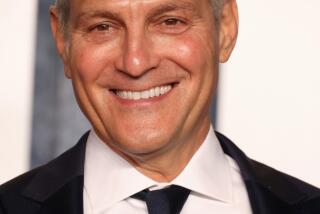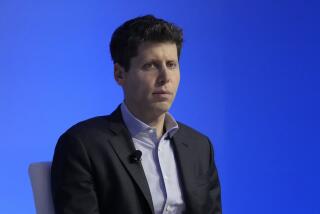AMI’s New Chief Wields Scalpel to Cut Heavy Debt : Health Care: Harry J. Gray believes that his experience as the former head of United Technologies will help him in his quest to lighten the debt burden of the recent buyout.
- Share via
In the 1970s as head of United Technologies, Harry J. Gray was one of the master builders of the giant conglomerate. Today, as chairman of American Medical International, Gray has traded his trowel for a scalpel as he tries to whittle down the hospital company that he and a group of investors acquired last October for $1.67 billion.
In a recent interview, the 70-year-old executive said he doesn’t intend to dismantle AMI, but he has moved aggressively on his predecessors’ plans to sell $1 billion in AMI assets and drastically reduce the corporate staff to cope with the buyout debt. To date, Gray said AMI has sold two hospitals for about $200 million.
AMI has stated a goal of reducing the corporate staff to about 400 people from about 1,000 (down from about 1,500 last year) who work in Beverly Hills, Marina del Rey, Costa Mesa and field offices outside California. Gray said he expects that there will be about 100 people at the new corporate headquarters when the company completes a planned move to Dallas from Beverly Hills. The company may also make more cuts in its data processing operations in Marina del Rey and Costa Mesa, he said. “We’ve had a lot of data processing that may not be absolutely necessary,” he said.
When AMI announced its move last month, the Beverly Hills headquarters had about 200 people, and the Marina del Rey and Orange County sites combined had about 200.
Before his involvement with AMI, Gray’s closest look at the health-care industry was from the perspective of a patient--one lying flat on his back in traction. More than two decades ago, he suffered a serious motorcycle accident that shattered his thighs and put him on crutches for eight months. He sealed his reputation for toughness and tenacity when he moved his office into the hospital, missing only two days of work.
Analysts caution that hospitals present a unique set of management problems for Gray. For one thing, demand for services is largely beyond the control of managers, they said, and hospitals in particular are under pressure from competitors to maintain costly equipment while government and private insurers demand that they limit patient stays and justify their fees.
Although his management experience has been mostly in defense industries, Gray said his experience with service companies owned by United Technologies will apply to AMI. “I find it rather comfortable moving into AMI. There are quite a few analogies I find helpful, especially in cost control,” he said.
He said the health-care industry has not been sufficiently attentive to controlling costs. “To survive, they must deliver quality on a cost-effective basis,” Gray said. AMI has already implemented an incentive program for hospital executive directors. The managers win and lose points based on how they manage their working capital, how discharged patients respond to an independent survey on the quality of their treatment and an outside review of the performance of the hospital’s doctors, he said.
The program thus far has resulted in some “pleasant” surprises, Gray said. Some of the hospitals targeted for sale because of lackluster performance are doing better. That doesn’t necessarily mean that they won’t be sold, but it “does make them more palatable” to potential buyers. Hospitals that were targeted for sale, he said, were those that could not produce enough operating cash flow to pay for capital improvements and to contribute their share of the total AMI debt.
AMI intends to sell all 23 of its foreign hospitals and about seven of the domestic hospitals, leaving the restructured AMI to operate about 40 hospitals. Despite analysts’ worries that AMI would not get the best prices for the hospitals because the industry has far more hospitals for sale than buyers, Gray said the two AMI hospitals sold so far attracted bids higher than expected. The company sold its Singapore hospital and a facility in North Miami Beach, Fla.
Gray said his goal is not only to pare costs at AMI, but to foster a new “corporate culture.” He explained: “Our purpose is to convince the people who are not directly associated with a hospital that their function in life is to serve the hospitals.” To foster that, Gray said the new corporate headquarters will be known as the “service center.” Gray said the role of chief executive was not one that he envisioned for himself when he decided last year that AMI was a good investment. IMA Acquisition Corp., jointly owned by Gray’s investment firm and First Boston Corp., won a bidding contest for AMI triggered last spring when a group led by M. Lee Pearce, an AMI director and major shareholder, proposed to buy the company.
“There was no intent to go back into active management,” Gray said, explaining that he had little choice when AMI Chairman and Chief Executive Richard Gilleland resigned suddenly after the buyout. Gilleland had been brought to AMI less than a year earlier after successfully turning around a troubled Texas health-care concern. Shareholders, dissatisfied with the pace of AMI’s recovery from a $97.3-million loss in 1986, had pressured Gilleland’s predecessor, Walter Weisman, to resign in 1988.
Gilleland said earlier that he didn’t want to invest in an AMI buyout and decided he didn’t want to manage the company long term, Gray said. “I think he did the best that he could for the shareholders. I think he was surprised that others wanted to buy the company,” he said. Gilleland couldn’t be reached for comment.
Some analysts speculated that Gilleland resigned because he feared that Gray would demand too big of a decision-making role after he joined the board upon completion of the buyout.
As head of United Technologies for 14 years, Gray was known for a reluctance to share power and groom a successor. Four men who might have succeeded him as chairman either quit or were forced to resign, associates said. Gray was accused of ordering the bugging of the home and office of one of the company’s presidents before the man’s resignation. But a committee of United Technologies directors cleared him in an internal investigation conducted in 1984, and Gray has always steadfastly denied the alleged bugging. That same year, as Gray neared the mandatory retirement age of 65, directors forced him to choose a successor. Gray retired at the end of 1986 and was succeeded by Robert F. Daniell, who was earlier elected president and chief executive.
A Georgia native who started his career in sales, Gray held various posts at Litton Industries in California in the 1950s and ‘60s. He became United Technologies’ president in 1971. By the time he left, he had built the Hartford, Conn.-based company from a $2-billion aerospace company to a $16.3-billion conglomerate and a leading defense contractor.
Some people called him “the shark” and “Jack the Ripper” for his record of successful takeovers, such as that of Otis Elevator and Carrier Corp. If there is a notable blemish on Gray’s record as a shrewd manager, it was United Technologies’ 1982 involvement in the complicated takeover battle between Bendix Corp. and Martin Marietta Corp. United Technologies baffled many observers when it jumped into the fray as an ally of Martin Marietta, which had responded to an unsolicited takeover bid from Bendix by attempting to swallow Bendix instead. Of the companies involved in the so-called Pac Man war, United Technologies emerged relatively unscathed as Allied Corp. leaped in and swallowed Bendix, and Martin Marietta remained independent at a huge cost.
More to Read
Inside the business of entertainment
The Wide Shot brings you news, analysis and insights on everything from streaming wars to production — and what it all means for the future.
You may occasionally receive promotional content from the Los Angeles Times.










